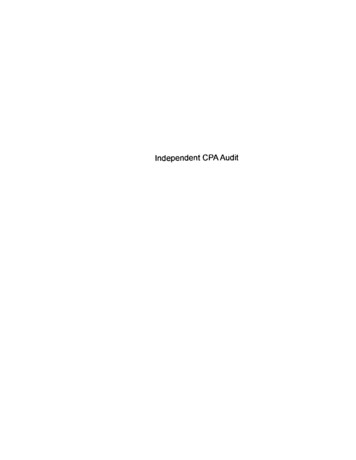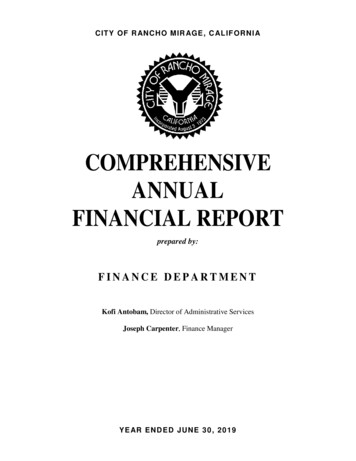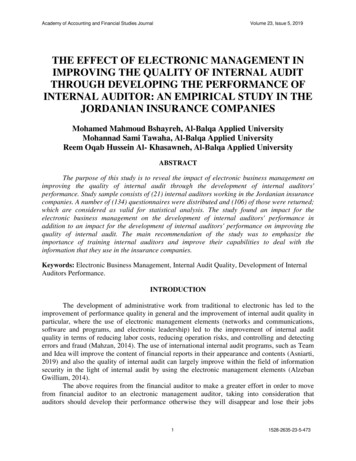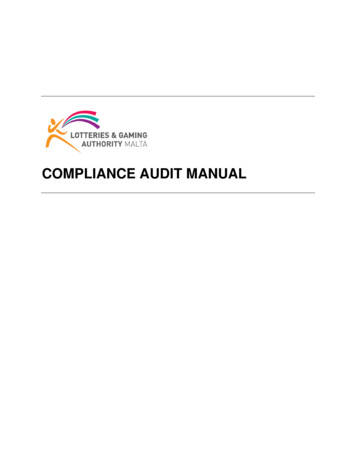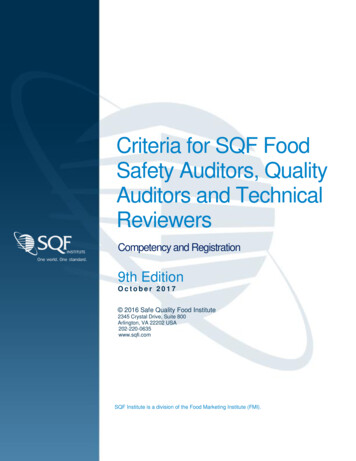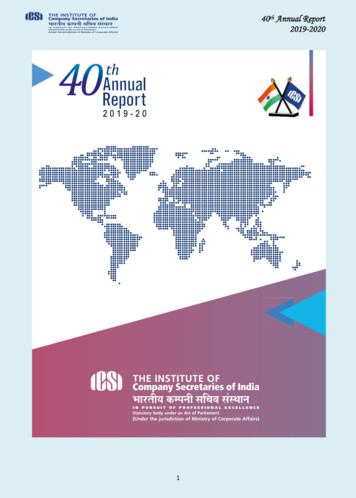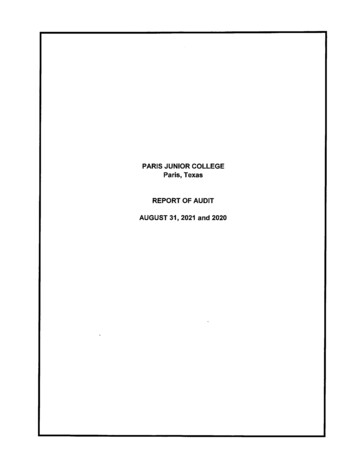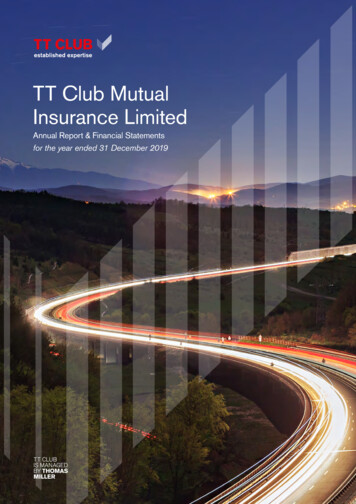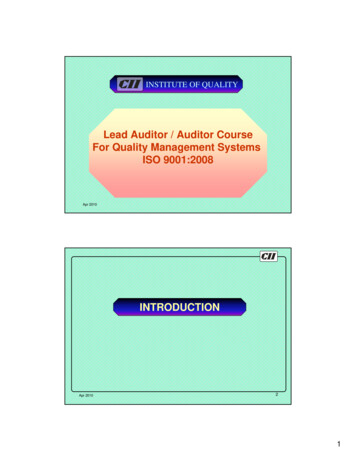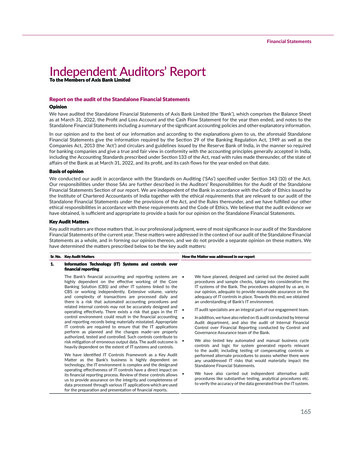
Transcription
Financial StatementsIndependent Auditors’ ReportTo the Members of Axis Bank LimitedReport on the audit of the Standalone Financial StatementsOpinionWe have audited the Standalone Financial Statements of Axis Bank Limited (the ‘Bank’), which comprises the Balance Sheetas at March 31, 2022, the Profit and Loss Account and the Cash Flow Statement for the year then ended, and notes to theStandalone Financial Statements including a summary of the significant accounting policies and other explanatory information.In our opinion and to the best of our information and according to the explanations given to us, the aforesaid StandaloneFinancial Statements give the information required by the Section 29 of the Banking Regulation Act, 1949 as well as theCompanies Act, 2013 (the ‘Act’) and circulars and guidelines issued by the Reserve Bank of India, in the manner so requiredfor banking companies and give a true and fair view in conformity with the accounting principles generally accepted in India,including the Accounting Standards prescribed under Section 133 of the Act, read with rules made thereunder, of the state ofaffairs of the Bank as at March 31, 2022, and its profit, and its cash flows for the year ended on that date.Basis of opinionWe conducted our audit in accordance with the Standards on Auditing (‘SAs’) specified under Section 143 (10) of the Act.Our responsibilities under those SAs are further described in the Auditors’ Responsibilities for the Audit of the StandaloneFinancial Statements Section of our report. We are independent of the Bank in accordance with the Code of Ethics issued bythe Institute of Chartered Accountants of India together with the ethical requirements that are relevant to our audit of theStandalone Financial Statements under the provisions of the Act, and the Rules thereunder, and we have fulfilled our otherethical responsibilities in accordance with these requirements and the Code of Ethics. We believe that the audit evidence wehave obtained, is sufficient and appropriate to provide a basis for our opinion on the Standalone Financial Statements.Key Audit MattersKey audit matters are those matters that, in our professional judgment, were of most significance in our audit of the StandaloneFinancial Statements of the current year. These matters were addressed in the context of our audit of the Standalone FinancialStatements as a whole, and in forming our opinion thereon, and we do not provide a separate opinion on these matters. Wehave determined the matters prescribed below to be the key audit matters:Sr. No. Key Audit Matters1.How the Matter was addressed in our reportInformation Technology (IT) Systems and controls overfinancial reportingThe Bank’s financial accounting and reporting systems arehighly dependent on the effective working of the CoreBanking Solution (CBS) and other IT systems linked to theCBS or working independently. Extensive volume, varietyand complexity of transactions are processed daily andthere is a risk that automated accounting procedures andrelated internal controls may not be accurately designed andoperating effectively. There exists a risk that gaps in the ITcontrol environment could result in the financial accountingand reporting records being materially misstated. AppropriateIT controls are required to ensure that the IT applicationsperform as planned and the changes made are properlyauthorized, tested and controlled. Such controls contribute torisk mitigation of erroneous output data. The audit outcome isheavily dependent on the extent of IT systems and controls.We have identified IT Controls Framework as a Key AuditMatter as the Bank’s business is highly dependent ontechnology, the IT environment is complex and the design andoperating effectiveness of IT controls have a direct impact onits financial reporting process. Review of these controls allowsus to provide assurance on the integrity and completeness ofdata processed through various IT applications which are usedfor the preparation and presentation of financial reports. e have planned, designed and carried out the desired auditWprocedures and sample checks, taking into consideration theIT systems of the Bank. The procedures adopted by us are, inour opinion, adequate to provide reasonable assurance on theadequacy of IT controls in place. Towards this end, we obtainedan understanding of Bank’s IT environment. IT audit specialists are an integral part of our engagement team. I n addition, we have also relied on IS audit conducted by InternalAudit department, and also the audit of Internal FinancialControl over Financial Reporting conducted by Control andGovernance Assurance team of the Bank. e also tested key automated and manual business cycleWcontrols and logic for system generated reports relevantto the audit; including testing of compensating controls orperformed alternate procedures to assess whether there wereany unaddressed IT risks that would materially impact theStandalone Financial Statements. e have also carried out independent alternative auditWprocedures like substantive testing, analytical procedures etc.to verify the accuracy of the data generated from the IT system.165
StandaloneSr. No. Key Audit Matters2.How the Matter was addressed in our reportIncome Recognition, Asset Classification (IRAC) andprovisioning on Loans & Advances and Investments as perthe regulatory requirementsPlease refer to Note no. 4.4 (a) of Schedule 18 relating to AssetQuality in respect of movement of Non-Performing Assets(NPAs) and related provisions and disclosures with regard toNon Performing Investments (NPI) respectively as also Noteno. 2 of Schedule 18 regarding the provisions made due to thepotential impact of Covid-19 pandemic.The Bank, as per its governing framework, undertakes theperforming and non-performing advances/investmentsprovisions based on Management’s assessment of the degreeof impairment of the advances subject to and guided byminimum provisioning levels prescribed under RBI guidelines.The management of the Bank relies on its automated ITsystems to determine asset classification, income recognition,provisioning for standard and non-performing advances/investments and for compliance of applicable regulatoryguidelines issued by the RBI. The management supplementsits assessment by availing services of experts (like independentvaluers, lawyers, legal experts and other professionals) todetermine the valuation and enforceability of security of suchadvances/investments.Compliance of relevant prudential norms issued by theReserve Bank of India (RBI) in respect of income recognition,asset classification and provisioning pertaining to advances aswell as those pertaining to investments is a key audit matterdue to materiality, complexity and uncertainty involved andthe current processes at the Bank which requires certainmanual interventions, management estimates and judgement.Our audit approach included testing the design, operating effectivenessof internal controls and substantive audit procedures in respect ofincome recognition, asset classification and provisioning pertaining toadvances and investments. In particular: e have evaluated and understood the Bank’s internal controlWsystem in adhering to the relevant RBI guidelines regardingincome recognition, asset classification and provisioningpertaining to advances and investments; e have tested key IT systems/ applications used and theirWdesign and implementation as well as operational effectivenessof relevant controls, including involvement of manual processand manual controls in relation to income recognition,asset classification, provisioning pertaining to advances andinvestments and compliances of other regulatory guidelinesissued by the RBI; e have test checked advances to examine the validity ofWthe recorded amounts, loan documentation, examined thestatement of accounts, indicators of impairment, impairmentprovision for non-performing assets, and compliance withincome recognition, asset classification and provisioningpertaining to advances in terms of applicable RBI guidelines; e have evaluated the past trends of management judgement,Wgovernance process and review controls over impairmentprovision calculations and discussed the provisions made withthe top and senior management of the Bank; e have also relied on work done by external experts likeWvaluers, lawyers, concurrent auditors etc. on specific areas.Information other than the Standalone Financial Statements and Auditors’ Report thereonThe Bank’s management and Board of Directors are responsible for the Other Information. The other information comprisesthe information included in the Annual Report but does not include the Standalone Financial Statements, ConsolidatedFinancial Statements and our auditors’ report thereon and the Pillar III Disclosures under Basel III Capital Regulation, LeverageRatio, Liquidity Coverage Ratio and Net Stable Funding Ratio. The other information is expected to be made available to usafter the date of this auditors’ report.Our opinion on the Standalone Financial Statements does not cover the other information and we do not express any form ofassurance conclusion thereon.In connection with our audit of the Standalone Financial Statements, our responsibility is to read the Other Informationidentified above when it becomes available and, in doing so, consider whether the Other Information is materially inconsistentwith the Standalone Financial Statements or our knowledge obtained in the audit or otherwise appears to be materiallymisstated. When we read the other information, if we conclude that there is a material misstatement therein, we are requiredto communicate the matter to those charged with governance.Responsibilities of Management and Those Charged with Governance for the Standalone Financial StatementsThe Bank’s Board of Directors and Management are responsible for the matters stated in Section 134(5) of the Act withrespect to the preparation of these Standalone Financial Statements that give a true and fair view of the state of affairs, profitand cash flows of the Bank in accordance with the accounting principles generally accepted in India, including the AccountingStandards specified under Section 133 of the Act, provisions of Section 29 of the Banking Regulation Act, 1949 and thecirculars and guidelines issued by Reserve Bank of India (‘RBI’) from time to time. This responsibility also includes maintenanceof adequate accounting records in accordance with the provisions of the Act, for safeguarding of the assets of the Bank and forpreventing and detecting frauds and other irregularities; selection and application of appropriate accounting policies; makingjudgments and estimates that are reasonable and prudent; and design, implementation and maintenance of adequate internalfinancial controls that were operating effectively for ensuring the accuracy and completeness of the accounting records,relevant to the preparation and presentation of the Standalone Financial Statements that give a true and fair view and are freefrom material misstatement, whether due to fraud or error.166Annual Report 2021-22
Financial StatementsIn preparing the Standalone Financial Statements, the Management and Board of Directors are responsible for assessing theBank’s ability to continue as a going concern, disclosing, as applicable, matters related to going concern and using the goingconcern basis of accounting unless the Management and Board of Directors either intends to liquidate the Bank or to ceaseoperations, or has no realistic alternative but to do so.The Board of Directors is also responsible for overseeing the Bank’s financial reporting process.Auditors’ Responsibilities for the Audit of the Standalone Financial StatementsOur objectives are to obtain reasonable assurance about whether the Standalone Financial Statements as a whole are free frommaterial misstatement, whether due to fraud or error, and to issue an auditors’ report that includes our opinion. Reasonableassurance is a high level of assurance, but is not a guarantee that an audit conducted in accordance with SAs will always detecta material misstatement when it exists. Misstatements can arise from fraud or error and are considered material if, individuallyor in the aggregate, they could reasonably be expected to influence the economic decisions of users taken on the basis of theseStandalone Financial Statements.As part of an audit in accordance with SAs, we exercise professional judgment and maintain professional skepticism throughoutthe audit. We also: Identify and assess the risks of material misstatement of the Standalone Financial Statements, whether due to fraud orerror, design and perform audit procedures responsive to those risks, and obtain audit evidence that is sufficient andappropriate to provide a basis for our opinion. The risk of not detecting a material misstatement resulting from fraud ishigher than for one resulting from error, as fraud may involve collusion, forgery, intentional omissions, misrepresentations,or the override of internal control. Obtain an understanding of internal control relevant to the audit in order to design audit procedures that are appropriatein the circumstances. Under Section 143(3)(i) of the Act, we are also responsible for expressing our opinion on whetherthe Bank has adequate internal financial controls with reference to financial statements in place and the operatingeffectiveness of such controls. Evaluate the appropriateness of accounting policies used and the reasonableness of accounting estimates and relateddisclosures in the Standalone Financial Statements made by the Management and Board of Directors. Conclude on the appropriateness of the Management and Board of Directors use of the going concern basis of accountingand, based on the audit evidence obtained, whether a material uncertainty exists related to events or conditions thatmay cast significant doubt on the Bank’s ability to continue as a going concern. If we conclude that a material uncertaintyexists, we are required to draw attention in our auditors’ report to the related disclosures in the Standalone FinancialStatements or, if such disclosures are inadequate, to modify our opinion. Our conclusions are based on the audit evidenceobtained up to the date of our auditors’ report. However, future events or conditions may cause a Bank to cease tocontinue as a going concern. Evaluate the overall presentation, structure and content of the Standalone Financial Statements, including the disclosures,and whether the Standalone Financial Statements represent the underlying transactions and events in a manner thatachieves fair presentation.We communicate with those charged with governance regarding, among other matters, the planned scope and timing of theaudit and significant audit findings, including any significant deficiencies in internal control that we identify during our audit.We also provide those charged with governance with a statement that we have complied with relevant ethical requirementsregarding independence, and to communicate with them all relationships and other matters that may reasonably be thought tobear on our independence, and where applicable, related safeguards.From the matters communicated with those charged with governance, we determine those matters that were of mostsignificance in the audit of the Standalone Financial Statements of the current period and are therefore the key audit matters.We describe these matters in our auditors’ report unless law or regulation precludes public disclosure about the matter or when,in extremely rare circumstances, we determine that a matter should not be communicated in our report because the adverseconsequences of doing so would reasonably be expected to outweigh the public interest benefits of such communication.Other MattersThe Standalone Financial Statements of the Bank for the previous year ended March 31, 2021 were audited by the predecessorauditors. The auditors have expressed unmodified opinion vide their report dated April 27, 2021 on such financial statements.Accordingly, we do not express any opinion on the same.Our opinion on the Standalone Financial Statements is not modified in respect of above matter.167
StandaloneReport on other legal and regulatory requirementsThe standalone balance sheet and the standalone profit and loss account have been drawn up in accordance with the provisionsof Section 29 of the Banking Regulation Act, 1949 and Section 133 of the Act.A.As required by sub-section (3) of Section 30 of the Banking Regulation Act, 1949, we report that:(a)we have obtained all the information and explanations which, to the best of our knowledge and belief, werenecessary for the purpose of our audit and have found them to be satisfactory;(b)the transactions of the Bank, which have come to our notice, have been within the powers of the Bank; andB.C.Further, as required by Section 143(3) of the Act, we report that:(a)we have sought and obtained all the information and explanations which to the best of our knowledge and beliefwere necessary for the purposes of our audit;(b)in our opinion, proper books of account as required by law have been kept by the Bank so far as it appears fromour examination of those books;(c)the standalone balance sheet, the standalone profit and loss account, and the standalone cash flow statementdealt with by this Report are in agreement with the books of account;(d)in our opinion, the aforesaid Standalone Financial Statements comply with the Accounting Standards specifiedunder Section 133 of the Act, to the extent they are not inconsistent with the accounting policies prescribed by RBI;(e)on the basis of the written representations received from the directors as on March 31, 2022 taken on recordby the Board of Directors, none of the directors is disqualified as on March 31, 2022 from being appointed as adirector in terms of Section 164 (2) of the Act; and(f)with respect to the adequacy of the internal financial controls with reference to Standalone Financial Statementsof the Bank and the operating effectiveness of such controls, refer to our separate Report in ‘Annexure A’.With respect to the other matters to be included in the Auditors’ Report in accordance with Rule 11 of the Companies (Auditand Auditors) Rules, 2014, in our opinion and to the best of our information and according to the explanations given to us:i.the Bank has disclosed the impact of pending litigations as at March 31, 2022 on its financial position in its StandaloneFinancial Statements - Refer Schedule 12 - Contingent Liabilities to the Standalone Financial Statements;ii.the Bank has made provision, as required under the applicable law or accounting standards, for material foreseeablelosses, if any, on long-term contracts including derivative contracts - Refer Schedule 5 read with note 5.15 ofSchedule 18 to the Standalone Financial Statements in respect of such items as it relates to the Bank;iii.there has been no delay in transferring amounts, required to be transferred, to the Investor Education andProtection Fund by the Bank;iv.a. The management has represented that, to the best of its knowledge and belief, other than as disclosedin the note 5.13 of Schedule 18 to the Standalone Financial Statements, no funds (which are materialeither individually or in the aggregate) have been advanced or loaned or invested (either from borrowedfunds or share premium or any other sources or kind of funds) by the Bank to or in any other person(s) orentity(ies), including foreign entities (“Intermediaries”), with the understanding, whether recorded in writingor otherwise, that the Intermediary shall, whether, directly or indirectly lend or invest in other persons orentities identified in any manner whatsoever by or on behalf of the Bank (“Ultimate Beneficiaries”) or provideany guarantee, security or the like on behalf of the Ultimate Beneficiaries.168since the key operations of the Bank are automated with the key applications integrated to the core bankingsystems, the audit is carried out centrally as all the necessary records and data required for the purposes of ouraudit are available therein. However, during the course of our audit we have visited 82 branches (including creditunits) to examine the records maintained at such branches for the purpose of our audit.b. Further, the management has represented that, to the best of its knowledge and belief, other than as disclosedin the note 5.13 of Schedule 18 to the Standalone Financial Statements, no funds (which are material eitherindividually or in the aggregate) have been received by the Bank from any person(s) or entity(ies), includingforeign entities (“Funding Parties”), with the understanding, whether recorded in writing or otherwise, thatthe Bank shall, whether, directly or indirectly, lend or invest in other persons or entities identified in anyAnnual Report 2021-22
Financial Statementsmanner whatsoever by or on behalf of the Funding Party (“Ultimate Beneficiaries”) or provide any guarantee,security or the like on behalf of the Ultimate Beneficiaries. Based on such audit procedures that wereconsidered reasonable and appropriate in the circumstances, nothing has come to our notice that has causedus to believe that the representations under sub-clause (a) and (b) above contain any material misstatement.v.D.As stated in note 5.3 of Schedule 18 to the Standalone Financial Statements, the Board of Directors of theBank has proposed final dividend for the financial year 2021-2022 which is subject to the approval of the membersat the ensuing Annual General Meeting. The amount of dividend proposed is in accordance with Section 123of the Companies Act.With respect to the matter to be included in the Auditors’ Report under Section 197(16) of the Act:The Bank is a banking company as defined under Banking Regulation Act, 1949. Accordingly, the requirementsprescribed under Section 197 of the Companies Act, 2013 do not apply by virtue of Section 35B(2A) of the BankingRegulation Act, 1949.For M P Chitale & Co.Chartered Accountants(ICAI FRN 101851W)For CNK & Associates LLPChartered Accountants(ICAI FRN 101961W/W100036)Ashutosh PednekarPartner(ICAI M. No. 041037)UDIN: 22041037AIAAWV7885Manish SampatPartner(ICAI M. No. 101684)UDIN: 22101684AIAAPL4546Place: MumbaiDate: April 28, 2022Place: MumbaiDate: April 28, 2022169
StandaloneAnnexure A to the Independent Auditors’ Report of even date on the StandaloneFinancial Statements of Axis Bank Limited for the year ended March 31, 2022Report on the Internal Financial Controls with reference to the aforesaid Standalone Financial Statementsunder Clause (i) of sub-section 3 of Section 143 of the Companies Act, 2013 (“the Act”)We have audited the internal financial controls with reference to Standalone Financial Statements of Axis Bank Limited (“theBank”) as of March 31, 2022 in conjunction with our audit of the Standalone Financial Statements of the Bank for the yearended on that date.Management’s Responsibility for Internal Financial ControlsThe Bank’s management and Board of Directors are responsible for establishing and maintaining internal financial controls basedon the internal control over financial reporting criteria established by the Bank considering the essential components of internalcontrol stated in the Guidance Note on Audit of Internal Financial Controls Over Financial Reporting (‘the Guidance Note’)issued by the Institute of Chartered Accountants of India (‘the ICAI’). These responsibilities include the design, implementationand maintenance of adequate internal financial controls that were operating effectively for ensuring the orderly and efficientconduct of its business, including adherence to the Bank’s policies, the safeguarding of its assets, the prevention and detectionof frauds and errors, the accuracy and completeness of the accounting records, and the timely preparation of reliable financialinformation, as required under the Companies Act, 2013 (“the Act”).Auditors’ ResponsibilityOur responsibility is to express an opinion on the Bank’s internal financial controls with reference to Standalone FinancialStatements based on our audit. We conducted our audit in accordance with the Guidance Note on Audit of Internal FinancialControls Over Financial Reporting (‘the Guidance Note’) and the Standards on Auditing (‘the Standards’), issued by the ICAIand deemed to be, prescribed under Section 143(10) of the Act, to the extent applicable to an audit of internal financialcontrols over financial reporting, both issued by the ICAI. Those Standards and the Guidance Note require that we complywith ethical requirements and plan and perform the audit to obtain reasonable assurance about whether adequate internalfinancial controls with reference to financial statements were established and maintained and whether such controls operatedeffectively in all material respects.Our audit involves performing procedures to obtain audit evidence about the adequacy of the internal financial controls withreference to financial statements and their operating effectiveness. Our audit of internal financial controls with reference toStandalone Financial Statements included obtaining an understanding of internal financial controls, assessing the risk that amaterial weakness exists, and testing and evaluating the design and operating effectiveness of internal control based on theassessed risk. The procedures selected depend on the auditors’ judgment, including the assessment of the risks of materialmisstatement of the Standalone Financial Statements, whether due to fraud or error.We believe that the audit evidence we have obtained is sufficient and appropriate to provide a basis for our audit opinion onthe Bank’s internal financial controls with reference to Standalone Financial Statements.Meaning of Internal Financial Controls with Reference to Financial StatementsA Bank’s internal financial controls with reference to Standalone Financial Statements is a process designed to providereasonable assurance regarding the reliability of financial reporting and the preparation of Standalone Financial Statements forexternal purposes in accordance with generally accepted accounting principles. Bank’s internal financial control with referenceto financial statements includes those policies and procedures that1)pertain to the maintenance of records that, in reasonable detail, accurately and fairly reflect the transactions anddispositions of the assets of the Bank;2)provide reasonable assurance that transactions are recorded as necessary to permit preparation of Standalone FinancialStatements in accordance with generally accepted accounting principles, and that receipts and expenditures of the Bankare being made only in accordance with authorisations of management and directors of the Bank; and3)provide reasonable assurance regarding prevention or timely detection of unauthorised acquisition, use, or dispositionof the Bank’s assets that could have a material effect on the Standalone Financial Statements.Inherent Limitations of Internal Financial Controls with Reference to Financial StatementsBecause of the inherent limitations of internal financial controls with reference to Standalone Financial Statements, includingthe possibility of collusion or improper management override of controls, material misstatements due to error or fraud mayoccur and not be detected. Also, projections of any evaluation of the internal financial controls with reference to Standalone170Annual Report 2021-22
Financial StatementsFinancial Statements to future periods are subject to the risk that the internal financial controls with reference to StandaloneFinancial Statements become inadequate because of changes in conditions, or that the degree of compliance with the policiesor procedures may deteriorate.OpinionIn our opinion the Bank has maintained, in all respects, an adequate internal financial control system with reference to financialstatements and such internal financial controls with reference to the financial statements were operating effectively as atMarch 31, 2022, based on internal control over financial reporting criteria established by the Bank considering the essentialcomponents of internal control stated in the Guidance Note.For M P Chitale & Co.Chartered Accountants(ICAI FRN 101851W)For CNK & Associates LLPChartered Accountants(ICAI FRN 101961W/W100036)Ashutosh PednekarPartner(ICAI M. No. 041037)UDIN: 22041037AIAAWV7885Manish SampatPartner(ICAI M. No. 101684)UDIN: 22101684AIAAPL4546Place: MumbaiDate: April 28, 2022Place: MumbaiDate: April 28, 2022171
StandaloneBalance SheetAs at 31 March, 2022( in Thousands)ScheduleNo.As at31-03-2022As at31-03-202116,139,4966,127,4971,485,957-Reserves & 31,597Other Liabilities and 67,976,306940,345,056518,085,592Capital and LiabilitiesCapitalEmployees' Stock Options OutstandingTotalAssetsCash and Balances with Reserve Bank of India6Balances with Banks and Money at Call and Short 9Fixed Assets1045,723,50342,450,264Other Assets11763,254,780803,037,640TotalContingent ,72710,526,588,107669,474,382503,752,658Bills for CollectionSignificant Accounting Policies and Notes to Accounts17 & 18Schedules referred to above form an integral part of the Balance SheetIn terms of our report attached.For Axis Bank Ltd.For M P Chitale & Co.ICAI Firm Registration No.: 101851WChartered AccountantsRakesh MakhijaChairmanAshutosh PednekarPartnerMembership No.: 041037Rajiv AnandAmitabh ChaudhryDeputy Managing Director Managing Director & CEOFor CNK & Associates LLPICAI
These matters were addressed in the context of our audit of the Standalone Financial Statements as a whole, and in forming our opinion thereon, and we do not provide a separate opinion on these matters. We have determined the matters prescribed below to be the key audit matters: Sr. No. Key Audit Matters How the Matter was addressed in our .
